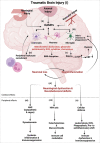Neuroprotection: Surgical approaches in traumatic brain injury
- PMID: 38344089
- PMCID: PMC10858784
- DOI: 10.25259/SNI_774_2023
Neuroprotection: Surgical approaches in traumatic brain injury
Abstract
Background: This review is centered on the pivotal role of surgical interventions within the comprehensive management of traumatic brain injury (TBI). Surgical strategies are indispensable components of TBI care, encompassing primary injury management and the alleviation of secondary injury processes, including the handling of intracranial hemorrhages (ICHs), contusions, and mass lesions.
Methods: A systematic review was carried out by searching databases including PubMed, Embase, and Scopus. The inclusion criteria involved studies discussing surgical strategies for TBI, with a focus on primary injury management, ICHs, contusions, and mass lesions. More recent articles were prioritized, and data were synthesized to assess the impact of surgical interventions on TBI outcomes.
Results: The evolution of surgical technologies has heralded a transformation in TBI management. These advancements encompass minimally invasive procedures, neuroimaging-guided surgeries, and robotic-assisted techniques, all geared toward optimizing patient outcomes.
Conclusion: Surgical interventions within TBI care present unique challenges, such as timing considerations, patient selection criteria, and postoperative care. This review underscores the critical significance of multidisciplinary collaboration among neurosurgeons, neurologists, and critical care specialists. Such collaboration is essential to tailor surgical strategies to the individualized needs of patients. Moreover, the review highlights emerging trends in TBI surgery and underscores the ongoing imperative of research endeavors aimed at refining surgical protocols and ultimately enhancing patient outcomes.
Keywords: Cisternostomy; Decompressive craniectomy; Intracranial hemorrhages; Neuroimaging-guided surgeries; Traumatic brain injury.
Copyright: © 2024 Surgical Neurology International.
Conflict of interest statement
There are no conflicts of interest.
Figures



Similar articles
-
Cisternostomy versus Decompressive Craniectomy for the Management of Traumatic Brain Injury: A Randomized Controlled Trial.World Neurosurg. 2022 Jun;162:e58-e64. doi: 10.1016/j.wneu.2022.02.067. Epub 2022 Feb 19. World Neurosurg. 2022. PMID: 35192970 Clinical Trial.
-
Basal Cisternostomy - A Microsurgical Cerebro Spinal Fluid Let Out Procedure and Treatment Option in the Management of Traumatic Brain Injury. Analysis of 40 Consecutive Head Injury Patients Operated with and without Bone Flap Replacement Following Cisternostomy in a Tertiary Care Centre in India.Neurol India. 2021 Mar-Apr;69(2):328-333. doi: 10.4103/0028-3886.314535. Neurol India. 2021. PMID: 33904445
-
Surgical management of traumatic brain injury: a review of guidelines, pathophysiology, neurophysiology, outcomes, and controversies.J Neurosurg Sci. 2014 Dec;58(4):249-59. J Neurosurg Sci. 2014. PMID: 25418276 Review.
-
Surgical management of traumatic brain injury: a comparative-effectiveness study of 2 centers.J Neurosurg. 2014 Feb;120(2):434-46. doi: 10.3171/2013.9.JNS13581. Epub 2013 Nov 1. J Neurosurg. 2014. PMID: 24180566
-
Neuroprotection strategies in traumatic brain injury: Studying the effectiveness of different clinical approaches.Surg Neurol Int. 2024 Jan 26;15:29. doi: 10.25259/SNI_773_2023. eCollection 2024. Surg Neurol Int. 2024. PMID: 38344087 Free PMC article. Review.
Cited by
-
Neurosteroids Progesterone and Dehydroepiandrosterone: Molecular Mechanisms of Action in Neuroprotection and Neuroinflammation.Pharmaceuticals (Basel). 2025 Jun 23;18(7):945. doi: 10.3390/ph18070945. Pharmaceuticals (Basel). 2025. PMID: 40732235 Free PMC article. Review.
References
-
- Bohman LE, Schuster JM. Decompressive craniectomy for management of traumatic brain injury: An update. Curr Neurol Neurosci Rep. 2013;13:392. - PubMed
-
- Bullock MR, Chesnut R, Ghajar J, Gordon D, Hartl R, Newell DW, et al. Surgical management of acute epidural hematomas. Neurosurgery. 2006;58:S7–15. - PubMed
-
- Bullock MR, Chesnut R, Ghajar J, Gordon D, Hartl R, Newell DW, et al. Surgical management of acute subdural hematomas. Neurosurgery. 2006;58:S16–24. discussion Si-iv. - PubMed
-
- Bullock MR, Chesnut R, Ghajar J, Gordon D, Hartl R, Newell DW, et al. Surgical management of traumatic parenchymal lesions. Neurosurgery. 2006;58:S2–46. - PubMed
Publication types
LinkOut - more resources
Full Text Sources
